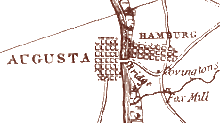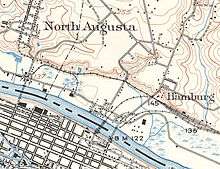Hamburg, Aiken County, South Carolina

The ghost town of Hamburg, South Carolina, was once a thriving upriver market located in Edgefield District (now Aiken County) of the Piedmont. It was founded by Henry Shultz in 1821, across the Savannah River from Augusta, Georgia, in direct competition with that city (Cordle 1940:82). In its heyday, 60,000 bales of cotton worth $2,000,000 were brought by wagon to Hamburg each year (Chapman 1897:237). This cotton continued by pole boat or steam boat to the ports of Charleston or Savannah for subsequent shipment to manufacturers in New England or Europe. Hamburg lost business after Augusta completed its canal in 1848.
After the American Civil War, Hamburg was repopulated mostly by freedmen and was within newly organized Aiken County. It became notorious in July 1876 as the site of a massacre of blacks by whites in what was one of a number of violent incidents by Democratic paramilitary groups to suppress black voting in that year's elections. The Democrats regained control of the state government and federal troops were withdrawn the next year from South Carolina and other states, ending the Reconstruction era.
History
During his American tour as 'Guest of the Nation', the Marquis de Lafayette visited Hamburg on March 24, 1825 (Cashin 1980:86). The town became the western terminus of the South Carolina Railroad. This was the world's first railroad in the modern pattern. Providing scheduled steam service over 136 miles of line from Charleston to Hamburg, it was the world's longest at its completion in 1833 (Derrick 1930:58-59). A railroad bridge was constructed over the Savannah River in 1854 but Hamburg was already in decline.
With completion of the Augusta Canal (1848) and general expansion of railroads in the 1850s, strenuous overland hauls to Hamburg became unnecessary and the famous wagon traffic declined (Chapman 1897:238). Hamburg became a ghost town by the time of the Civil War (Chapman 1897:20).

Following the war, Hamburg was repopulated and governed by freedmen, starting with Prince Rivers; Samuel J. Lee, a free man before the war, who was elected as the speaker of the House and was the first black man admitted to the South Carolina Bar; and Charles D. Hayne, a freeman from an elite Charleston family. These three men were founders of Aiken County. They began to redevelop Hamburg, attracting freedmen. To celebrate Aiken County's 125th anniversary, a stone-and-bronze marker was installed at the county courthouse. Rivers, Hayne and Leeld are listed as founders but their race is not indicated.[1]
After the deaths and damage in the Hamburg Massacre of July 8, 1876, the town declined for good (Vandervelde 1999:154). Augusta began construction of a river levee after a 1911 flood (Cashin 1980:210), but Hamburg remained unprotected. Particularly disastrous floods finally forced out the last residents in 1929 .

Geography
Occasionally styled as Hamburgh (especially after The War), the town was named after Shultz's home town in Germany. It was located at 33.4799°N, 81.9579°W directly across the Savannah River from Augusta, Georgia. Population at its peak in the 1840s reached 2,500 (Haskel 1843:257), and exceeded 1,000 in the 1870s (Budiansky 2008). For the most part the town was on the Savannah River floodplain. Under protection of the Clarks Hill Dam and Lake, adjacent North Augusta has begun to develop on the grounds of old Hamburg.
Notable people
- James E. Broome, governor of Florida from 1853-1857.[2]
- Marcus Junius Parrott, delegate to the U.S. Congress from Kansas Territory from 1857-1861.[3]
References
- ↑ "County, once booming, now shadows town it used to rival", Augusta Chronicle, July 2014, hosted at Rootsweb
- ↑ "Florida Governor James Emilius Broome". National Governors Association. Retrieved Sep 2013. Check date values in:
|access-date=(help) - ↑ "PARROTT, Marcus Junius, (1828 - 1879)". Biographical Directory of the United States Congress. Retrieved Sep 2013. Check date values in:
|access-date=(help)
- Haskel, Daniel (1843). Descriptive and Statistical Gazetteer of the United States of America. Sherman & Smith. ISBN 0-8063-4696-5.
- Chapman, John A. (1897). History of Edgefield County, South Carolina. Various Reprints. ISBN 0-8063-4696-5. pp. 20 and 236-243
- Derrick, Samuel Melanchthon (1930). Centennial History of South Carolina Railroad. State Company, Columbia, SC.
- Cordle, Charles G. (1940). Henry Shultz and the Founding of Hamburg, South Carolina. Studies in Georgia History and Government. University of Georgia Press. pp. 79–93 and 257-263
- Cashin, Edward J. (1980). The Story of Augusta. Various Reprints. ISBN 0-87152-452-X.
- Vandervelde, Isabel (1999). Aiken County: The Only South Carolina County Founded During Reconstruction. Reprint Company Publishers. ISBN 0-87152-517-8.
- Budiansky, Stephen (2008). The Bloody Shirt: Terror After Appomattox. Viking Penguin. ISBN 0-670-01840-6.
External links
- Henry Shultz and his Town of Hamburg, SC Accessed March 2015
- City of Dust: Honky Tonk Hell
- 1835 Hamburg Town Plat
- Streets of Hamburg shown on 1884 Sanborn Map of Augusta, Georgia. Hamburg is located just right of center of the Augusta index map
Coordinates: 33°29′N 81°57′W / 33.483°N 81.950°W